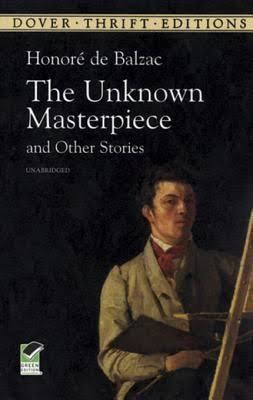Illustrator Pierre Vidal Publication date 1831 Preceded by Melmoth réconcilié | Originally published August 1831 Genre Fiction Followed by Gambara | |
 | ||
Publisher Louise-Marie-Julienne Charles-Béchet Similar Honoré de Balzac books, La Comédie humaine books, Classical Studies books | ||
Le Chef-d’œuvre inconnu (English "The Unknown Masterpiece") is a short story by Honoré de Balzac. It was first published in the newspaper L'Artiste with the title "Maître Frenhofer" (English: "Master Frenhofer") in August 1831. It appeared again later in the same year under the title "Catherine Lescault, conte fantastique." It was published in Balzac's Études philosophiques in 1837 and was integrated into the Comédie humaine in 1846.
Contents
"Le Chef-d’œuvre inconnu" is a reflection on art, and has had an important influence on modernist artists.
Plot summary
Young Nicolas Poussin, as yet unknown, visits the painter Porbus in his workshop. He is accompanied by the old master Frenhofer who comments expertly on the large tableau that Porbus has just finished. The painting is of Mary of Egypt, and while Frenhofer sings her praises, he hints that the work seems unfinished. With some slight touches of the paintbrush, Frenhofer transforms Porbus' painting such that Mary the Egyptian appears to come alive before their very eyes. Although Frenhofer has mastered his technique, he admits that he has been unable to find a suitable model for his own masterpiece, which depicts a beautiful courtesan called Catherine Lescault, known as La Belle noiseuse. He has been working on this future masterpiece, that no one has yet seen, for ten years. Poussin offers his own lover, Gillette, as a model. Gillette is so beautiful that Frenhofer is inspired to finish his project quickly. Poussin and Porbus come to admire the painting, but all they can see is part of a foot that has been lost in a swirl of colors. Their disappointment drives Frenhofer to madness, and he destroys the painting and dies that night.
Influence on artists
Paul Cézanne strongly identified with Frenhofer, once saying "Frenhofer, c’est moi" (I am Frenhofer). Critic Jon Kear argues that Cézanne's own attempts to paint the nude were heavily influenced by Balzac's portrayal of Frenhofer's work.
In 1921, Ambroise Vollard asked Picasso to illustrate Le Chef-d’œuvre inconnu. Picasso was fascinated by the text and identified with Frenhofer so much that he moved to the rue des Grands-Augustins in Paris where Balzac located Porbus' studio. There he painted his own masterpiece, Guernica. Picasso lived here during World War II.
Adaptations
Sidney Peterson's 1949 avant-garde film Mr Frenhofer and the Minotaur was based on the link between the short story and the work of Picasso. It draws on Picasso's Minotauromachy, bringing Picasso's work to life with the characters of Gillette, Poussin and Porbus participating.
"Le Chef-d’œuvre inconnu" inspired the film la Belle Noiseuse by Jacques Rivette (1991).
